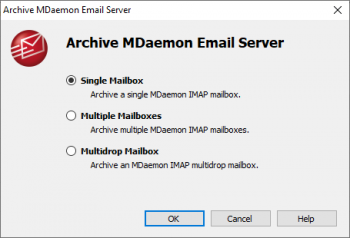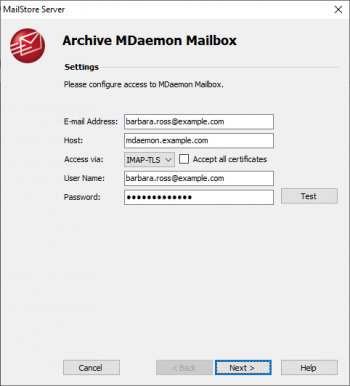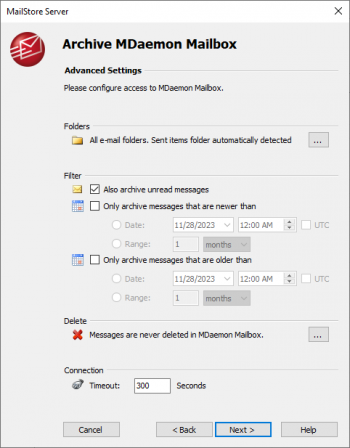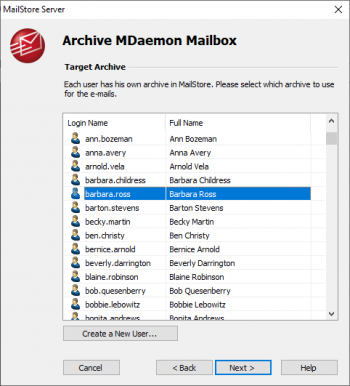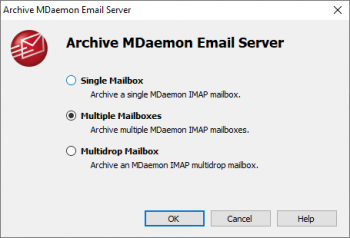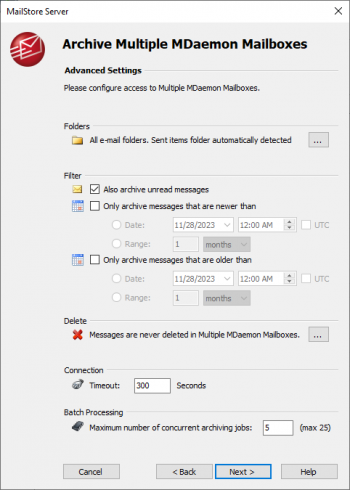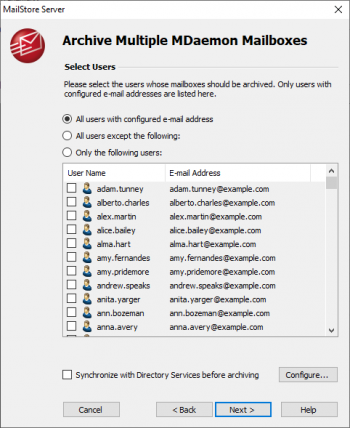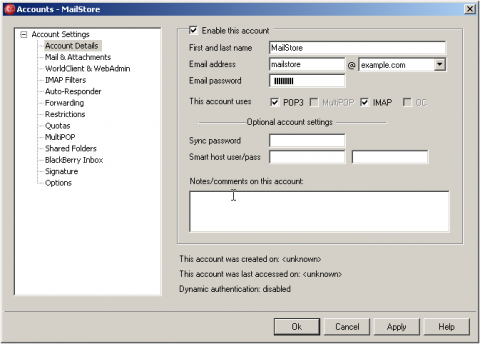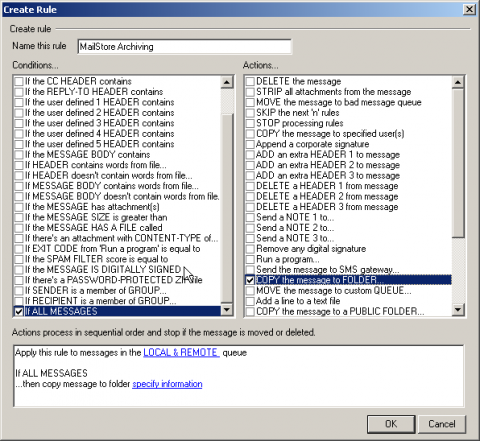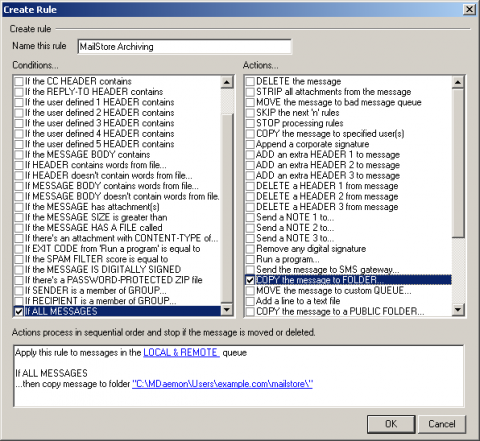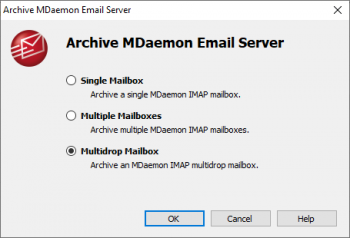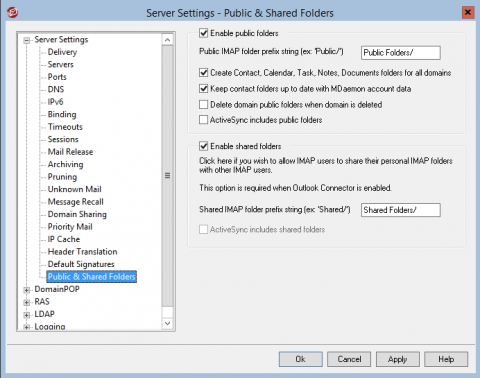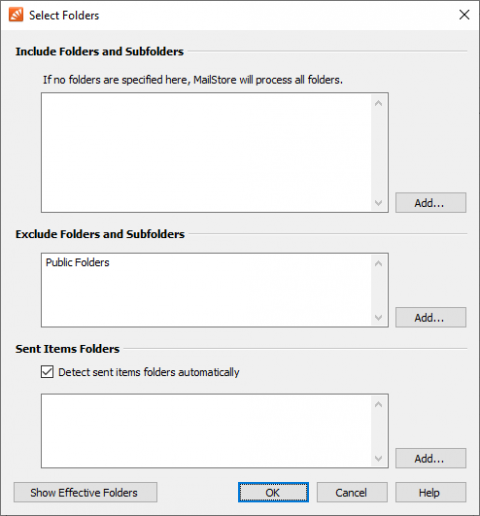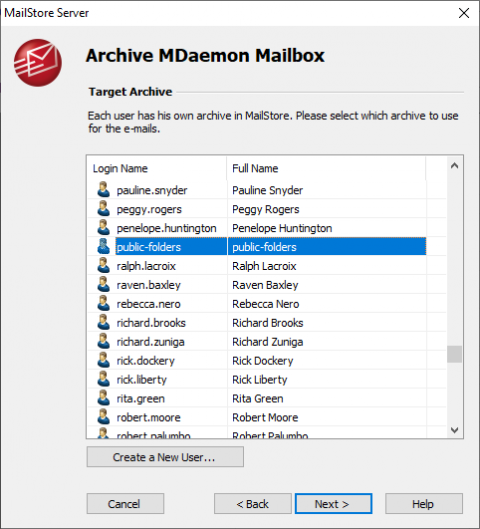Difference between revisions of "Archiving Emails from MDaemon"
| [unchecked revision] | [checked revision] |
| (79 intermediate revisions by 5 users not shown) | |||
| Line 1: | Line 1: | ||
| − | + | {{Implementation_Guide_Preamble|MDaemon Email Server}} | |
| − | + | == Synchronizing Users == | |
| + | In addition to the internal user databases, MDaemon may also use SQL databases or LDAP directory services such as Active Directory or OpenLDAP to manage and authenticate users. It is recommended to set up directory service synchronization in MailStore as well. Additional information on synchronizing users can be found in the corresponding chapters of the MailStore Server manual: | ||
| − | + | * [[MDaemon Integration]] (recommended) | |
| + | * [[Active Directory Integration]] | ||
| + | * [[Generic LDAP Integration]] | ||
| + | * [[Application Integration]] (SPE) | ||
| − | + | == Archiving Individual Mailboxes == | |
| + | {{Archiving Single Mailbox Preamble|MDaemon}} | ||
| + | {{Archiving Single Mailbox|MDaemon Email Server|Mdaemon_mailbox_00.png|Mdaemon_mailbox_01.png|Mdaemon_mailbox_02.png|Mdaemon_mailbox_03.png}} | ||
| − | = Archiving Multiple Mailboxes in One Step = | + | == Archiving Multiple Mailboxes in One Step == |
| + | * Log on to MailStore Client as administrator. | ||
| + | * Click on ''Archive Email''. | ||
| + | * From the ''Email Servers'' list under ''Create Profile'' select ''MDaemon Email Server'' to create a new archiving profile. | ||
| + | * A wizard opens to assist in specifying the archiving settings. | ||
| + | *:[[File:Mdaemon_mailboxes_00.png|center|350px]] | ||
| + | * Select ''Multiple Mailboxes''. | ||
| + | *: {{Archiving_Multiple_or_Multidrop_Note|multiple mailboxes|[[#Synchronizing_Users|directory synchronization]]}} | ||
| + | *:[[File:Mdaemon_mailboxes_01.png|center|350px]] | ||
| + | * Under ''Host'' enter the name or IP address of your MDaemon Email Server. | ||
| + | * From ''Access via'' select the protocol used to access the MDaemon Email Server. It is recommended to select either ''IMAP-TLS'' or ''IMAP-SSL''. | ||
| + | *: '''Please Note:''' {{Option_Accept_all_certificates}} | ||
| + | * Under ''User Name'' and ''Password'', enter the access data of a user who has access to all the MDaemon mailboxes to be archived. This is usually a MDaemon administrator. | ||
| + | * Under ''Special Folder (optional)'' you may enter the name of the IMAP folder containing sent messages. | ||
| + | * Click on ''Next'' to continue. | ||
| + | * Customize the [[Email_Archiving_with_MailStore_Basics#Selecting_Folders_for_Archiving|list of folders to be archived]], the [[Email_Archiving_with_MailStore_Basics#Specifying_Filter_Criteria_for_Archiving|filter]] and the [[Email_Archiving_with_MailStore_Basics#Deleting_Emails_after_Archiving|deletion rules]]. By default, no emails will be deleted from a mailbox. The ''Timeout'' value only has to be adjusted in specific cases (e.g. with very slow servers). Please keep in mind that these settings apply to all mailboxes to be archived. | ||
| + | *: [[File:Mdaemon_mailboxes_02.png|center|350px]] | ||
| + | *: '''Please note:''' ''Public Folders'' and ''Shared Folders'' to which a user has access, will be archived into the user's own archive by default. Please refer to the [[Archiving_Emails_from_MDaemon#Public_Folders|public folders section]] on how to prevent this. | ||
| + | * Click ''Next'' to continue. | ||
| + | {{Archiving_Multiple_Mailboxes_Centrally_Options|Mdaemon_mailboxes_03.png|MDaemon}} | ||
| − | + | == Archiving Incoming and Outgoing Emails Directly == | |
| − | + | The MDaemon Email Server offers an easy way to deliver all emails to an MDaemon specific multidrop mailbox. MailStore Server archives this mailbox by means of an archiving task of type [[Archiving IMAP and POP3 Multidrop Mailboxes]]. | |
| − | = Archiving Incoming and Outgoing Emails Directly = | ||
| − | The MDaemon | ||
=== Step 1: Create a new account to be used as multidrop mailbox for archiving === | === Step 1: Create a new account to be used as multidrop mailbox for archiving === | ||
| − | + | * Add a new account by selecting ''Accounts'' and then ''New Account''. | |
| − | * Add a new account by selecting ''' | ||
* Name the account ''mailstore'' and assign a strong password. | * Name the account ''mailstore'' and assign a strong password. | ||
| − | * In the following screenshot you can see the sample configuration for the mailbox ''mailstore@ | + | * In the following screenshot you can see the sample configuration for the mailbox ''mailstore@example.com'' |
| − | + | *: [[File:Md_user_01.png|480px|center]] | |
| − | [[File:Md_user_01.png| | ||
=== Step 2: Create a new content filter rule for archiving === | === Step 2: Create a new content filter rule for archiving === | ||
| − | + | * Open the content filter editor by selecting ''Security'' an then ''Content Filter''. | |
| − | * Open the content filter editor by selecting ''' | + | * If not yet enabled, enable the rules processing engine. |
| − | * Click on ''New rule'' | + | * Click on ''New rule''. |
| − | *:[[File:Md_cf_01.png|center| | + | * Choose a name for the new rule, e.g. "MailStore Archiving". |
| − | * | + | * Under ''Conditions...'' select the checkbox ''If ALL MESSAGES'' and under ''Actions...'' select the checkbox ''COPY the message to FOLDER...''. |
| + | *:[[File:Md_cf_01.png|center|480px]] | ||
| + | * In the text area on the bottom of the window, click on the link ''specify information''. | ||
| + | * In the window ''Copy message to folder...'' click on ''Browse''. | ||
| + | * Select the directory of the account you created in step 1. | ||
*:[[File:Md_cf_02.png|center]] | *:[[File:Md_cf_02.png|center]] | ||
| − | * | + | * Click on ''OK'' to confirm the path specified. |
| − | + | * The configuration is now complete. | |
| − | + | *:[[File:Md_cf_03.png|center|480px]] | |
| − | |||
| − | |||
| − | |||
| − | |||
| − | |||
| − | |||
| − | |||
| − | |||
| − | * The configuration now complete. | ||
| − | *:[[File: | ||
*Click on ''OK'' to save the new content filter rule. | *Click on ''OK'' to save the new content filter rule. | ||
| − | === Step 3: | + | === Step 3: Configuration of MailStore Server === |
| − | + | {{Archiving Multidrop Mailbox|MDaemon Email Server|Mdaemon_catchall_00.png|Mdaemon_catchall_01.png|[[#Synchronizing_Users|directory synchronization]]}} | |
| − | |||
| − | |||
| − | |||
| − | |||
| − | |||
| − | |||
| − | |||
| − | |||
| − | |||
| − | |||
| − | |||
| − | |||
| − | |||
| − | |||
| − | |||
| − | |||
| − | |||
| − | |||
| − | |||
| − | |||
| − | |||
| − | |||
| − | |||
| − | |||
| − | |||
| − | |||
| − | |||
| − | |||
| − | |||
| − | |||
| − | |||
| − | == | + | == Public Folders == |
| − | + | Public folders in MDaemon are shown inside the users' mailboxes in a folder that can be specified by an MDaemon administrator in the ''Server Settings''. | |
| − | + | [[File:Mdaemon-public-folders-shared-folders-en.png|center|480px]] | |
| + | With MailStore's default settings, the archiving profiles ''Single Mailbox'' and ''Multiple Mailboxes'' will archive public folders into the user's own archive. If that behavior is not desired, Public Folders can be excluded from being archived by the regular archiving profiles of the users' mailboxes and instead archived into a separate archive, for the costs of one additional user license. The following describes how this can be accomplished. | ||
| − | = | + | === Exclude Public Folders from regular archiving profiles === |
| + | * Log on to MailStore Client as MailStore administrator . | ||
| + | * Click on ''Archive E-Mail''. | ||
| + | * Right click on an existing MDaemon archiving profile and click on ''Properties''. | ||
| + | * Click on ''Next'' to get to ''Advanced Settings''. | ||
| + | * In the ''Folders'' section click on the button with the three dots. | ||
| + | * Add the name of MDaemon's public folders into the ''Exclude Folders and Subfolders'' text area. By default the name is ''Public Folders''. | ||
| + | *: [[File:Mdaemon-public-folders-filter-en.png|center|480px]] | ||
| + | *: '''Please note:''' ''Shared Folders'' can also be excluded by adding the name of MDaemon's shared folders to the exclude list. This prevents archiving "foreign" messages into a user's archive. Refer to [[Users,_Folders_and_Settings#Specifying_Privileges|Specifying Privileges]] to find out how to give users access on other archives. | ||
| + | * Save the changes made to the archiving profile. | ||
| − | * [ | + | === Creating a dedicated archiving profile for Public Folders === |
| + | * Log on to MailStore Client as MailStore administrator . | ||
| + | * Create a [[Users,_Folders_and_Settings#Creating_a_New_User|new user]] into whose archive the public folders should be archived. This user requires one additional license. | ||
| + | * Create a new archiving profile of the type ''MDaemon'' > ''[[Archiving_Emails_from_MDaemon#Archiving_Individual_Mailboxes|Single Mailbox]]''. | ||
| + | * Use the credentials of a user that has at least read permissions on the public folders. | ||
| + | * Click on ''Next'' to get to ''Advanced Settings''. | ||
| + | * In the ''Folders'' section click on the button with the three dots. | ||
| + | * Add the name of MDaemon's public folders to the ''Include Folders and Subfolders'' text area. By default the name is ''Public Folders''. | ||
| + | *: [[File:Mdaemon-public-folders-filter-include-en.png|center|480px]] | ||
| + | * This profile will ignore all user messages in other folders and will archive public folders only. | ||
| + | * Close the dialog and click on ''Next''. | ||
| + | * Select the previously created user as ''Target Archive''. | ||
| + | *: [[File:Mdaemon-public-folders-user-en.png|center|480px]] | ||
| + | * Finish the creation of this archiving profile. | ||
| + | * Refer to [[Users,_Folders_and_Settings#Specifying_Privileges|Specifying Privileges]] to find out how to give users access to the Public Folder archive. | ||
| + | |||
| + | == Weblinks == | ||
| + | * {{MailStore Support}} | ||
* [http://www.mdaemon.com MDaemon Homepage] | * [http://www.mdaemon.com MDaemon Homepage] | ||
| − | |||
| − | |||
[[de:E-Mail-Archivierung von MDaemon]] | [[de:E-Mail-Archivierung von MDaemon]] | ||
| + | [[en:Archiving_Emails_from_MDaemon]] | ||
Latest revision as of 16:06, 7 December 2020
This implementation guide covers the specifics of archiving MDaemon Email Server mailboxes. It is assumed that you already have a MailStore Server installation or test installation and are familiar with the fundamentals of MailStore Server. Please refer to the Manual or the Quick Start Guide for more information.
MailStore Server offers several ways to archive emails from MDaemon Email Server mailboxes, which are described below. If you are not sure which archiving method best suits your company, please refer to the chapter Choosing the Right Archiving Strategy.
Synchronizing Users
In addition to the internal user databases, MDaemon may also use SQL databases or LDAP directory services such as Active Directory or OpenLDAP to manage and authenticate users. It is recommended to set up directory service synchronization in MailStore as well. Additional information on synchronizing users can be found in the corresponding chapters of the MailStore Server manual:
- MDaemon Integration (recommended)
- Active Directory Integration
- Generic LDAP Integration
- Application Integration (SPE)
Archiving Individual Mailboxes
In MailStore Server MDaemon archiving tasks are stored in archiving profiles. By following the procedure described here you can archive a single MDaemon mailbox for a specific MailStore user. The archiving process can be executed manually or automatically. You can find further information about executing archiving profiles in chapter Email Archiving with MailStore Basics.
- Users can only archive their own mailboxes to their personal user archive. To archive the emails of other users, you have to be logged on to MailStore Client as MailStore administrator. Only MailStore administrators can archive the emails of other users.
- In MailStore, click on Archive Email.
- To create a new archiving profile, select MDaemon Email Server from the Email Servers list in the Create Profile area of the application window.
- A wizard opens guiding you through the setup process.
- Select Single Mailbox and click on OK.
- Fill out the fields Email Address, Host, Access via, User Name and Password. The Email Address is used to label the folder that is created in the archive by this profile. Click on Test to verify the data entered.
- For the IMAP-TLS and IMAP-SSL protocols only: If the certificate provided by the remote host cannot be verified (e.g. self-signed or signed by an unknown certificate authority), enable the option Accept all certificates to allow MailStore to establish a connection. As this option leads to an insecure configuration, warnings may appear in the summary and/or the dashboard.
- Click on Next.
- Customize the list of folders to be archived, the filter and the deletion rules. By default, no emails will be deleted from a mailbox. The timeout value only has to be adjusted as needed (e.g. with very slow servers).
- Please note: Public Folders and Shared Folders to which a user has access, will be archived into the user's own archive by default. Please refer to the public folders section on how to prevent this.
- Click on Next.
- If logged on to MailStore Server as administrator, the target archive can be specified at the next step. Select the archive of the user for whom the mailbox is to be archived.
- At the last step, a name for the new archiving profile can be specified. After clicking on Finish, the archiving profile will be listed under Saved Profiles and can be run immediately, if desired.
Archiving Multiple Mailboxes in One Step
- Log on to MailStore Client as administrator.
- Click on Archive Email.
- From the Email Servers list under Create Profile select MDaemon Email Server to create a new archiving profile.
- A wizard opens to assist in specifying the archiving settings.
- Select Multiple Mailboxes.
- Please note: To be able to archive multiple mailboxes, MailStore Server users along with their email addresses must exist in the MailStore Server user management. If this is not the case, MailStore Server will offer to set up and run the directory synchronization at this point. Once completed, the wizard will resume.
Alternatively, you can cancel the wizard and create users manually as described the in chapter User Management.
- Please note: To be able to archive multiple mailboxes, MailStore Server users along with their email addresses must exist in the MailStore Server user management. If this is not the case, MailStore Server will offer to set up and run the directory synchronization at this point. Once completed, the wizard will resume.
- Under Host enter the name or IP address of your MDaemon Email Server.
- From Access via select the protocol used to access the MDaemon Email Server. It is recommended to select either IMAP-TLS or IMAP-SSL.
- Please Note: If the certificate provided by the remote host cannot be verified (e.g. self-signed or signed by an unknown certificate authority), enable the option Accept all certificates to allow MailStore to establish a connection. As this option leads to an insecure configuration, warnings may appear in the summary and/or the dashboard.
- Under User Name and Password, enter the access data of a user who has access to all the MDaemon mailboxes to be archived. This is usually a MDaemon administrator.
- Under Special Folder (optional) you may enter the name of the IMAP folder containing sent messages.
- Click on Next to continue.
- Customize the list of folders to be archived, the filter and the deletion rules. By default, no emails will be deleted from a mailbox. The Timeout value only has to be adjusted in specific cases (e.g. with very slow servers). Please keep in mind that these settings apply to all mailboxes to be archived.
- Please note: Public Folders and Shared Folders to which a user has access, will be archived into the user's own archive by default. Please refer to the public folders section on how to prevent this.
- Click Next to continue.
- Select the users whose mailboxes are to be archived.
- The following options are available:
- All users with configured email address
Choose this option to archive the mailboxes of all users who are set up, along with their email addresses, in MailStore's user management. - All users except the following
Choose this option to exclude individual users (and thereby their MDaemon mailboxes) from the archiving process, using the list of users below. - Only the following users
Choose this option to include individual users (and thereby their MDaemon mailboxes) in the archiving process, using the list of users below. Only the mailboxes of those users explicitly specified will be archived. - Synchronize with Directory Services before archiving
If selected, the MailStore user list will be synchronized with the configured directory service before any archiving process is executed. This has the advantage that, for example, new employees will be created as MailStore users before archiving, so once the archiving process is executed, their MDaemon mailbox is archived automatically as well. This option is especially recommended when the archiving process is to be executed automatically.
- Click on Next.
- In the last step, a name for the archiving profile can be specified. After clicking Finish, the archiving profile will be listed under Saved Profiles and can be run immediately or automatically, if desired.
Archiving Incoming and Outgoing Emails Directly
The MDaemon Email Server offers an easy way to deliver all emails to an MDaemon specific multidrop mailbox. MailStore Server archives this mailbox by means of an archiving task of type Archiving IMAP and POP3 Multidrop Mailboxes.
Step 1: Create a new account to be used as multidrop mailbox for archiving
- Add a new account by selecting Accounts and then New Account.
- Name the account mailstore and assign a strong password.
- In the following screenshot you can see the sample configuration for the mailbox [email protected]
Step 2: Create a new content filter rule for archiving
- Open the content filter editor by selecting Security an then Content Filter.
- If not yet enabled, enable the rules processing engine.
- Click on New rule.
- Choose a name for the new rule, e.g. "MailStore Archiving".
- Under Conditions... select the checkbox If ALL MESSAGES and under Actions... select the checkbox COPY the message to FOLDER....
- In the text area on the bottom of the window, click on the link specify information.
- In the window Copy message to folder... click on Browse.
- Select the directory of the account you created in step 1.
- Click on OK to confirm the path specified.
- The configuration is now complete.
- Click on OK to save the new content filter rule.
Step 3: Configuration of MailStore Server
Setting up archiving processes for multidrop mailboxes is done using archiving profiles. General information about archiving profiles is available in chapter Working with Archiving Profiles.
Please proceed as follows:
- Log on as MailStore administrator using MailStore Client.
- In MailStore, click on Archive Email.
- To create a new archiving profile, select MDaemon Email Server from the Email Server list in the Create Profile area of the application window.
- A wizard opens guiding you through the setup process.
- Select Multidrop Mailbox and click OK.
- Please note: To be able to archive a multidrop mailbox, MailStore Server users along with their email addresses must exist in the MailStore Server user management. If this is not the case, MailStore Server will offer to set up and run the directory synchronization at this point. Once completed, the wizard will resume.
Alternatively, you can cancel the wizard and create users manually as described the in chapter User Management.
- Please note: To be able to archive a multidrop mailbox, MailStore Server users along with their email addresses must exist in the MailStore Server user management. If this is not the case, MailStore Server will offer to set up and run the directory synchronization at this point. Once completed, the wizard will resume.
- Fill out the fields Access via, Host, Username and Password. Click on Test to verify the data entered.
- For the TLS and SSL protocols only: If the certificate provided by the remote host cannot be verified (e.g. self-signed or signed by an unknown certificate authority), enable the option Accept all certificates to allow MailStore to establish a connection. As this option leads to an insecure configuration, warnings may appear in the summary and/or the dashboard.
- Adjust any further settings such as how to handle emails with unknown addresses.
- The placeholders {u-email} or {h-email} can be used under Target Folders. {u-email} represents a user's primary email address and {h-email} is the email address found in the email header. Should a user have multiple aliases, using {h-email} will result in emails sent to different aliases of a user being archived in different folders, while using {u-email} will file all emails below the primary email address.
- Notice: If you are additionally archiving messages from the users mailboxes, you have to set the target folder names here to the folder names that match the names that were created by the user mailbox archiving profiles. Otherwise, additional or similar folders could be created in the users' archives. The folder names are case-sensitive.
- If the option Synchronize with Directory Services before archiving is enabled, the MailStore user list will be synchronized with configured directory service before the archiving process actually runs. This has the advantage that, for example, new employees will be created as MailStore users before archiving which enables MailStore to sort their emails into the correct archives.
- Click on Next.
- You can specify Deletion Rules for when archived mails should be deleted from the multidrop mailbox. This makes it possible to align the deletion with your MailStore Server backup strategy. For example, in case of a daily backup the deletion can be postponed by a day.
- The timeout value only has to be adjusted on a case-by-case basis (e.g. with very slow servers).
- Click on Next.
- At the last step, select a name for the new archiving profile. After clicking on Finish, the archiving profile will be listed under Saved Profiles and can be run immediately or automatically, if desired.
Public Folders
Public folders in MDaemon are shown inside the users' mailboxes in a folder that can be specified by an MDaemon administrator in the Server Settings.
With MailStore's default settings, the archiving profiles Single Mailbox and Multiple Mailboxes will archive public folders into the user's own archive. If that behavior is not desired, Public Folders can be excluded from being archived by the regular archiving profiles of the users' mailboxes and instead archived into a separate archive, for the costs of one additional user license. The following describes how this can be accomplished.
Exclude Public Folders from regular archiving profiles
- Log on to MailStore Client as MailStore administrator .
- Click on Archive E-Mail.
- Right click on an existing MDaemon archiving profile and click on Properties.
- Click on Next to get to Advanced Settings.
- In the Folders section click on the button with the three dots.
- Add the name of MDaemon's public folders into the Exclude Folders and Subfolders text area. By default the name is Public Folders.
- Please note: Shared Folders can also be excluded by adding the name of MDaemon's shared folders to the exclude list. This prevents archiving "foreign" messages into a user's archive. Refer to Specifying Privileges to find out how to give users access on other archives.
- Save the changes made to the archiving profile.
Creating a dedicated archiving profile for Public Folders
- Log on to MailStore Client as MailStore administrator .
- Create a new user into whose archive the public folders should be archived. This user requires one additional license.
- Create a new archiving profile of the type MDaemon > Single Mailbox.
- Use the credentials of a user that has at least read permissions on the public folders.
- Click on Next to get to Advanced Settings.
- In the Folders section click on the button with the three dots.
- Add the name of MDaemon's public folders to the Include Folders and Subfolders text area. By default the name is Public Folders.
- This profile will ignore all user messages in other folders and will archive public folders only.
- Close the dialog and click on Next.
- Select the previously created user as Target Archive.
- Finish the creation of this archiving profile.
- Refer to Specifying Privileges to find out how to give users access to the Public Folder archive.
